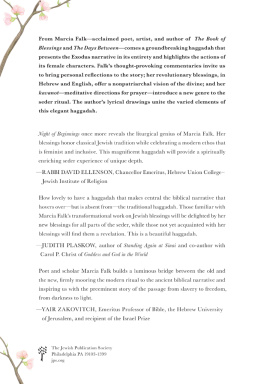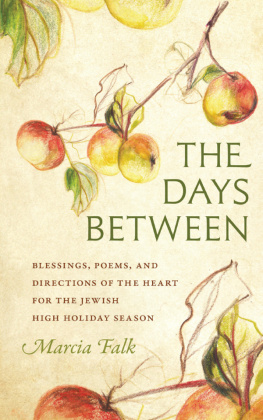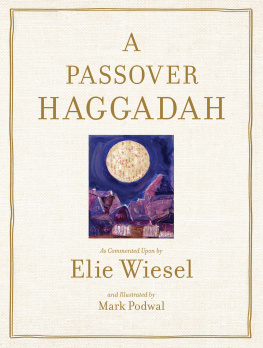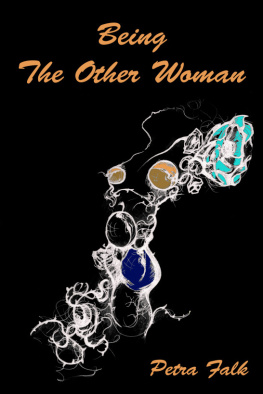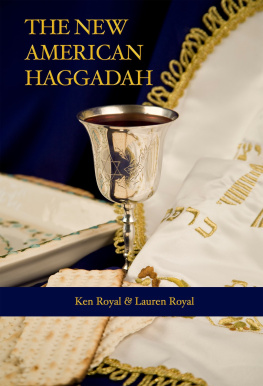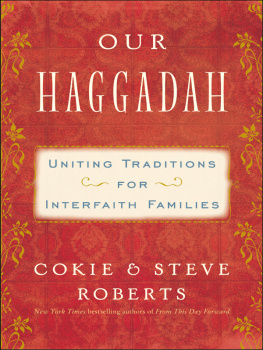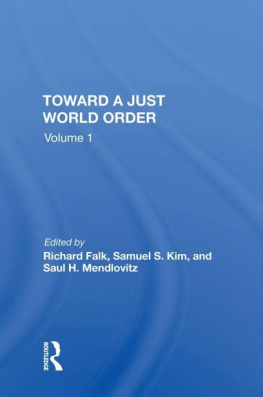Marcia Falk - Night of Beginnings: A Passover Haggadah
Here you can read online Marcia Falk - Night of Beginnings: A Passover Haggadah full text of the book (entire story) in english for free. Download pdf and epub, get meaning, cover and reviews about this ebook. year: 2022, publisher: U of Nebraska Press, genre: Religion. Description of the work, (preface) as well as reviews are available. Best literature library LitArk.com created for fans of good reading and offers a wide selection of genres:
Romance novel
Science fiction
Adventure
Detective
Science
History
Home and family
Prose
Art
Politics
Computer
Non-fiction
Religion
Business
Children
Humor
Choose a favorite category and find really read worthwhile books. Enjoy immersion in the world of imagination, feel the emotions of the characters or learn something new for yourself, make an fascinating discovery.
- Book:Night of Beginnings: A Passover Haggadah
- Author:
- Publisher:U of Nebraska Press
- Genre:
- Year:2022
- Rating:3 / 5
- Favourites:Add to favourites
- Your mark:
- 60
- 1
- 2
- 3
- 4
- 5
Night of Beginnings: A Passover Haggadah: summary, description and annotation
We offer to read an annotation, description, summary or preface (depends on what the author of the book "Night of Beginnings: A Passover Haggadah" wrote himself). If you haven't found the necessary information about the book — write in the comments, we will try to find it.
Marcia Falk: author's other books
Who wrote Night of Beginnings: A Passover Haggadah? Find out the surname, the name of the author of the book and a list of all author's works by series.
Night of Beginnings: A Passover Haggadah — read online for free the complete book (whole text) full work
Below is the text of the book, divided by pages. System saving the place of the last page read, allows you to conveniently read the book "Night of Beginnings: A Passover Haggadah" online for free, without having to search again every time where you left off. Put a bookmark, and you can go to the page where you finished reading at any time.
Font size:
Interval:
Bookmark:


 INTRODUCTION Walking through the walnut orchard, Looking for the signs of spring: The pomegranateshave they flowered? The grapevinesare they blossoming? SONG OF SONGS 6:11 A BOOK OF BEGINNINGS Springtime: the world is budding, the earth is blossoming; why not we too? This is the time of openings, and tonightthe first night of Pesachis a night of beginnings. The book that you hold in your hands is a book of and about beginnings, in which you are invited to take part. On Pesach we celebrate two beginnings: the departure from Egyptthe first step in our becoming a free peopleand the start of the year, which, in the Book of Exodus, takes place in the springtime month of Aviv (later called Nisan ). Thus the earths cycles and our peoples journey from slavery to freedom overlap in the Festival of Spring, ag Haaviv . ( ag Haaviv was one of the rabbis names for Pesach. The eleventh-century rabbi Shlomo Yitzhaki, known as Rashi, comments that the season and the journey are purposefully intertwined: he praises God for timing the Exodus in the spring, when travel is least arduous.) This haggadah itself is a new beginning.
INTRODUCTION Walking through the walnut orchard, Looking for the signs of spring: The pomegranateshave they flowered? The grapevinesare they blossoming? SONG OF SONGS 6:11 A BOOK OF BEGINNINGS Springtime: the world is budding, the earth is blossoming; why not we too? This is the time of openings, and tonightthe first night of Pesachis a night of beginnings. The book that you hold in your hands is a book of and about beginnings, in which you are invited to take part. On Pesach we celebrate two beginnings: the departure from Egyptthe first step in our becoming a free peopleand the start of the year, which, in the Book of Exodus, takes place in the springtime month of Aviv (later called Nisan ). Thus the earths cycles and our peoples journey from slavery to freedom overlap in the Festival of Spring, ag Haaviv . ( ag Haaviv was one of the rabbis names for Pesach. The eleventh-century rabbi Shlomo Yitzhaki, known as Rashi, comments that the season and the journey are purposefully intertwined: he praises God for timing the Exodus in the spring, when travel is least arduous.) This haggadah itself is a new beginning. But whywhy begin again? Why yet another new haggadah? Meaning: it is always about meaning. The intention of Night of Beginnings is to do more than update the traditional liturgy, to do more than make it consonant with contemporary thinking and sensibilities. This haggadah is an attempt to go beyond these aims to reveal meanings beneath the surface of the Pesach ritual and to deepen our personal connections to the holiday. FROM THEN TO NOW Night of Beginnings is modeled on the basic structure and themes of the traditional haggadah, and, at the same time, it participates in the centuries-long history of transformation and adaptation that yielded todays haggadot (plural of haggadah). It may be helpful to take a brief moment to look at this long history. The Pesach holiday has its origins in Tanakh (the Hebrew Bible) where, at Gods command, Moshe instructs the Israelites to create a festival honoring God for sparing them the death of their firstborns and for liberating them from enslavement in Egypt.
After the destruction of the Second Temple, the rabbis began to develop a ritual that could be enacted at the family table. From these earliest beginnings a version of the haggadah emerged and, over the course of many centuries, evolved. Not until well after the printing press was invented did the haggadah begin to resemble what we tend to think of today as the standard text (specifically, the Ashkenazic version from eastern Europe). But the history of its development shows that tradition wasand in fact still isconstantly being changed. In our times, we have seen a profusion of different kinds of haggadot . And yet, strikingly, one is hard-pressed to find in any haggadah, ancient or modern, a full recounting of the biblical story.
It is doubly ironic that, although the word-root of both haggadah and Maggid (the central portion of this haggadah) means telling, the standard haggadah does not actually tell the Exodus storyin fact, it does not offer a continuous narrative at all. Instead, it provides tastingsrabbinic anecdotes, comments, and exhortations, punctuated with biblical quotationsthat show us how the generations of rabbis who created and redacted the haggadah viewed the purpose and meaning of the Pesach festival and how they wanted us to view and observe it. For many of us, this compilation fails to engage the way that stories do and fails to draw us deeply into our own search for the festivals meaning. In recounting the full Bible story, Night of Beginnings seeks to provide a more direct connection to the origins of the holiday. Maggid: The Telling which is not only the centerpiece of this haggadah but one of its three main innovative elementsoffers a compressed version of the Exodus narrative, beginning with the Israelites enslavement and ending with their crossing the Sea of Reeds. Presented this way, the narrative is revealed to have a dramatic trajectory with an opening, a climax, and a denouement.
No attempt has been made here to make the character of God gender-inclusive; in the Exodus story God is decidedly male, and it is this story that we investigate and seek to understand tonight, in all its complexity. Importantly, unlike the standard haggadah, which omits any mention of the storys main human protagonists, Maggid: The Telling includes the voices and actions not just of Moshe and his brother, Aaron, but of the female characters, among them Moshes mother; his sister, Miriam; Pharaohs daughter, who adopts the baby Moshe; and the midwives Shifrah and Puah, who save the lives of Hebrew male infants. Interspersed throughout the narration is a new commentary, indicated in bold letters, that raises questions of interpretation and invites us to bring our personal experiences into the discussion. Besides Maggid: The Telling, Night of Beginnings offers two other major innovations: new brakhot (plural of brakhah , blessing), which are re-creations, in Hebrew and in English, of the traditional blessings; and kavanot (plural of kavanah , intention, or direction of the heart), a genre that is entirely new to the seder ritual. (Each of these elements is set apart in the design of the book; see the notes for the reader, which follow this introduction.) The new brakhot express a theology that differs distinctly from that of the traditional rabbinic blessings as well as from that of the Bible story. They envision the divinethe ineffable, the sacredas a greater whole of which we are an inseparable part.
They convey this vision with imagesnew metaphors, such as eyn haayim (wellspring of life) and mayan ayynu (flow of our lives)that replace the depiction of God as a lord and king. These new metaphors are neither anthropomorphic (not male and not female) nor abstract, but drawn largely from the natural world. Their inclusive language makes room for women to find and use our voices more full-throatedly than we were able to do with the patriarchal prayers we inherited from the early rabbis. In addition to offering new imagery, the brakhot differ from rabbinic prayer in their mode of address: rather than passively acknowledging a blessed You, they open with inclusive, active verbs, such as nvarekh (let us bless) and nodeh (let us thank), calling upon us, the human community, to perform the act of blessing. Some of the brakhot open directly with an image, leaving the invocation implied. Each brakhah is introduced with a quotation from Tanakh, linking it to our most ancient texts.
All the brakhot ask that we bring our attention to the fullness of the moment and, at times, that we commit to fulfilling the words of the blessing with action, not just ritually but in the acts of our ordinary daily lives. Brakhot are the core of every seder ritual, as they are in this haggadah; simply put, without them there is no seder. The kavanot in Night of Beginnings amplify the brakhot , and we might think of them as the seders heart. Although they are innovations they do not appear at all in the traditional ritualthey are founded on the rabbinic injunction to always bring something new to prayer; to pray, with intentionality, hatfilah shebalev (the prayer of the heart). If the brakhot are short lyric poems that touch down lightly on single momentsthe lighting of candles, the eating of matzahthe kavanot take the form of longer prose-poems and meditations, inviting us to delve more deeply and broadly, lingering over images, themes, and motifs, and allowing ourselves to enter more fully and more personally into the experience of the night. Interspersed among the three main innovative elements of this haggadahthe brakhot , the kavanot , and the Maggidare several kinds of embellishments: poems, psalms, and songs, as well as traditional readings that are usually sung, including Arba Hakushyot (the Four Questions), Shfaot Vaavadim Haynu (Once We Were Slaves), Ha Lama Anya (This Is the Bread of Affliction), Bkhol Dor Vador (In Every Generation), and Daynu (It Would Have Been Enough).
Font size:
Interval:
Bookmark:
Similar books «Night of Beginnings: A Passover Haggadah»
Look at similar books to Night of Beginnings: A Passover Haggadah. We have selected literature similar in name and meaning in the hope of providing readers with more options to find new, interesting, not yet read works.
Discussion, reviews of the book Night of Beginnings: A Passover Haggadah and just readers' own opinions. Leave your comments, write what you think about the work, its meaning or the main characters. Specify what exactly you liked and what you didn't like, and why you think so.

